Taekwondo 태권도Taekwondo Preschool
When you reach senior belt you are expected to guide the junior belts when they are beginning Taekwondo such as showing by example. To advance from one rank to the next, students typically complete promotion tests in which they demonstrate their proficiency in the various aspects of the art before a panel of judges or their teacher. View Taekwondo belt levels »
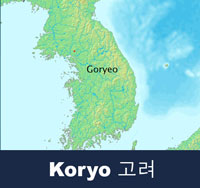
Koryo 고려
Goryeo, also known as Koryŏ (Hangul: 고려; hanja: 高麗; Korean pronunciation: [koɾjʌ]; 918–1392), was a Korean dynasty established in 918 by King Taejo.
This kingdom later gave name to the modern exonym for Korea. It united the Later Three Kingdoms in 936 and ruled most of the Korean peninsula until it was removed by the leader of the Joseon dynasty in 1392. The Goryeo dynasty expanded its borders to present-day Wonsan in the north-east (936–943) and the Amnok River (993) and finally almost the whole of the Korean peninsula (1374).
Two of this period's most notable products are Goryeo celadon pottery and the Tripitaka Koreana — the Buddhist scriptures (Tripitaka) carved onto roughly 80,000 woodblocks and stored, and still in, Haeinsa. Subjects and officials of the Goryeo dynasty also created the world's first metal-based movable type in 1234; the oldest surviving movable metal type book, the Jikji, was made in 1377.
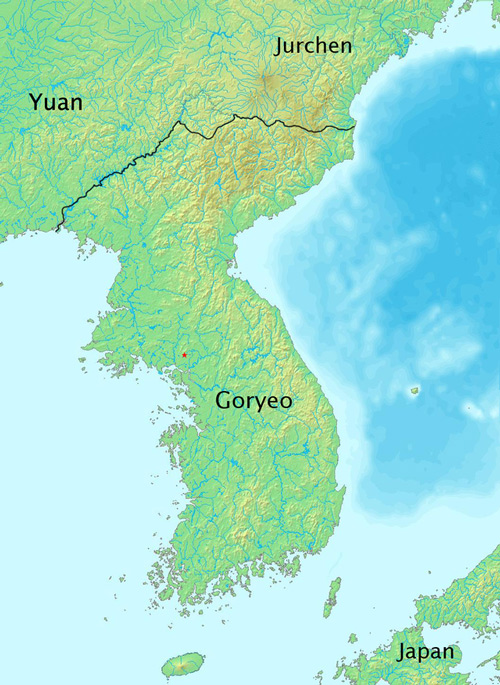
In 668, Silla conquered Baekje and Goguryeo with alliance of Tang Dynasty, but by the late 9th century it was tottering, its monarchs being unimaginative and pressed by the power of powerful statesmen. Many robbers and outlaws agitated and in 900 Gyeon Hwon revolted from Silla control in the Jeolla region as Hubaekje and next year Gung Ye revolted from the northern regions as Hugoguryeo (Taebong). A son of a regional lord, Wang Geon went into Hugoguryeo as a general.
Hugoguryeo fell when Wang Geon revolted and killed Gung Ye in 918; Silla was overpowered by Goryeo and Hubaekje and surrendered to Goryeo in 935. In 936 Hubaekje surrendered and Goryeo started an unbroken dynasty that ruled Korea for 474 years. By the 14th century Goryeo had lost much of its power under Yuan Dynasty influences. Although King Gongmin managed to free his kingdom from the Mongol influence, the Goryeo general Yi Seonggye revolted and overthrew the last king of Goryeo, King Gongyang in 1392. Gongyang was killed in 1394.
Etymology
The name "Goryeo" is derived from "Goguryeo", one of the ancient Three Kingdoms of Korea, which changed its name to "Goryeo" during the reign of King Jangsu of Goguryeo (in the 5th century). The English name "Korea" derives from "Goryeo.
Background
Silla, which had accomplished an incomplete unification of the Three Kingdoms of Korea in 668, weakened and lost control over local lords during the end of the 9th century. The country entered a period of civil war and rebellion, led by Gung Ye, Gi Hwon, Yang Gil, and Gyeon Hwon. Gung Ye established Hugoguryeo (meaning "Later Goguryeo", renamed Taebong and Majin). Gyeon Hwon established Hubaekje (meaning "Later Baekje"). Together with the declining Silla, they are known as the Later Three Kingdoms.
Founding
Wang Geon, a descendant of a merchant family of Songdo (present-day Kaesŏng), joined Taebong but overthrew Gung Ye and established the Goryeo Kingdom and Dynasty in 918.
Goryeo adopted a Silla-friendly Hubaekje-hostile stage in the later Three Kingdoms, but in 927, Goryeo was defeated by Hubaekje in present-day Daegu. Wang Geon lost his best supporters in the battle. For 3 years after the battle, Hubaekje dominated the Later Three Kingdoms but after a defeat at the Andong in 930, Hubaekje lost his power.
The Later Three Kingdoms era ended as Goryeo annexed Silla in 935 and defeated Hubaekje in 936. Wang Geon moved the capital to his hometown Kaesǒng, and ruled the Korean peninsula as the first King of Goryeo. Wang Geon married a daughter of the Silla royal family and let most nobles keep their lands. Even though Wang Geon ruled the united nation for only 7 years before his son took the reign after his death, the succession was not challenged.
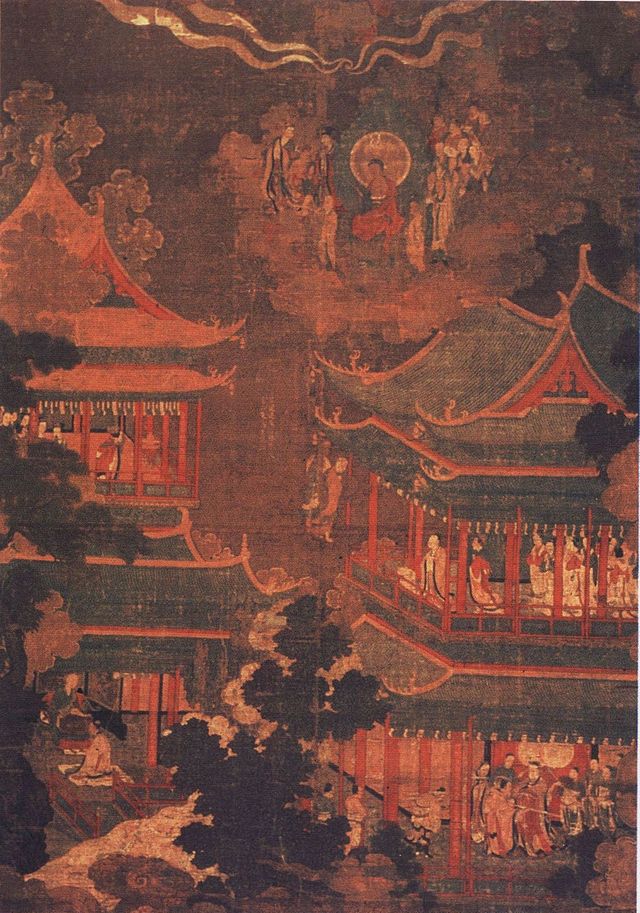
Political Structure
The terminology used in the court of Goryeo was that of an empire, not of a kingdom. The capital, Gaegyeong (Korean: 개경,Hanja: 開京,) was called "Imperial Capital" (Korean: 황도, Hanja: 皇都) and the palace was referred to as "Imperial Palace" (Korean: 황성, Hanja: 皇城). The nation also utilized a system of multiple capitals: Gaegyeong (modern-day Gaeseong), being the main capital, and Seogyeong (Korean: 서경, Hanja: 西京) (modern-day Pyongyang), Namgyeong (Korean: 남경, Hanja: 南京) (modern-day Seoul), and Donggyeong (Korean: 동경, Hanja: 東京) (modern-day Gyeongju) as secondary capitals. The mere use of this system and the nomenclature or use of the character "京“ implied that Goryeo functioned internally as an empire.
Other terms, such as "Your Imperial Majesty" (Korean: 성상, Hanja: 聖上), "Empress" (Korean: 황후, Hanja: 皇后) "Imperial Crown Prince" (Korean: 태자, Hanja: 太子), "Empress Dowager" (Korean: 태후, Hanja: 太后), and "Imperial Ordinance" (詔 or 勅) also suggest that Goryeo adopted the title system of an empire. However, Goryeo, when enshrining its rulers, did not use the title of "Emperor" (Korean: 황제, Hanja: 皇帝). Instead, the title of "Great King" (Korean: 대왕, Hanja: 大王) was used to posthumously enshrine Goryeo monarchs. When enshrining its rulers, however, it did use "temple names" such as Taejo (Korean: 태조, Hanja: 太祖); this is a practice mere kingdoms did not take part in. Imperial titles, like Emperor or "Haedong Emperor" (Korean: 해동천자, Hanja: 海東天子, lit. the Son of Heaven Ruling the Land East of the Sea)" were also used.
After the Mongol invasions, all of these terms were prohibited by Mongol rulers, and Goryeo monarchs were forced to insert the character “忠” (Korean: 충, romanization: "chung"), meaning loyal, into their posthumous enshrinement names. This is why the monarchs after Wonjong had this character "忠” in their posthumous names, up until Gongmin. As Mongol power diminished, rulers no longer used "忠,” but still were unable to restore the use of the temple name.
In order to strengthen the power of the central government, Gwangjong, the fourth emperor, made a series of laws including that of freeing slaves in 958, and one creating the exam for hiring civil officials. To assert power internationally, Gwangjong also proclaimed Goryeo an empire, independent from any other country of its day.
The fifth king, Gyeongjong, launched land-ownership reformation called Jeonsigwa (Korean: 전시과, Hanja: 田柴科) and the 6th king, Seongjong of Goryeo appointed officials to local areas, which were previously succeeded by the lords. Between 993 and 1019, the Goryeo-Khitan Wars ravaged the northern border. By the time of eleventh king, Munjong of Goryeo, the central government of Goryeo gained complete authority and power over local lords. Munjong and later kings emphasized the importance of civilian leadership over the military.
Khitan Invasion and Jurchen expedition
In 993, the Khitan Liao Dynasty invaded Goryeo's northwest border with an estimated 60,000 troops. However, after Seo Hui's negotiation with Khitan, they withdrew and ceded territory to the east of the Amrok River (also called Yalu River) when Goryeo agreed to end its alliance with Song Dynasty China. However, Goryeo continued to communicate with the Song, having strengthened its position by building a fortress in the newly gained northern territories.
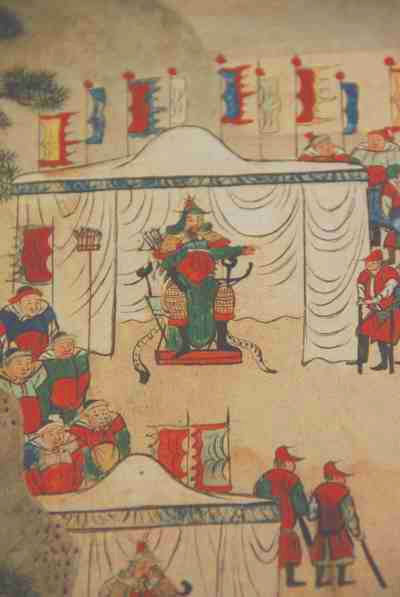
Meanwhile, In 1009, General Gang Jo of Goryeo led a coup against King Mokjong, killing the monarch and establishing military rule. In 1010, The Khitan attacked again with 400,000 troops during an internal Goryeo power struggle. Gang Jo blocked the Liao invasions until his own death. The Goryeo King Hyeonjong was forced to flee the capital to Naju temporarily. Unable to establish a foothold and fearing a counterattack, the Khitan forces withdrew.
In 1018, the Khitan army invaded for the third time with 100,000 troops. In Heunghaejin stream, General Gang Gam-chan ordered the stream to be blocked until the Khitans began to cross it, and when the Khitans were mid-way across, he ordered that the dam be destroyed so that the water would drown much of the Khitan army. The damage was great, and General Gang led a massive attack that annihilated many of the Khitan army. Barely a few thousand of the Liao troops survived after the bitter defeat at Kwiju one year later.
Meanwhile, the Jurchen tribes lived to the north of Goryeo. The Jurchens always rendered tribute to the Goryeo monarchs, but the Jurchen tribes grew strong, and were soon united under Wanyan. They began to violate the Goryeo-Jurchen borders, and eventually invaded Goryeo. In 1087, the first version of the Tripitaka Koreana was completed, after many years of labor.
In 1107, General Yun Gwan led the newly formed Goryeo army, a force of approximately 17,000 men called Byeolmuban, and attacked the Jurchens. Though the war lasted for several years, the Jurchen were ultimately defeated, and surrendered to Yun Gwan. To mark the victory, General Yun built nine fortresses to the northeast of the Goryeo-Jurchen borders (Korean:동북 9성, Hanja:東北九城). In 1108, however, General Yun was given orders to withdraw his troops by Goryeo's new ruler, King Yejong. Due to manipulation and court-intrigue from opposing factions, he was discharged from his post. Along with this, the opposing factions fought to make sure that the new nine fortresses were returned to the Jurchens.
Power Struggles
The House Yi of Inju (Korean: 인주 이씨, Hanja: 仁州李氏) married the Kings from Munjong to the 17th King, Injong. Eventually the Yis gained more power than the monarch himself. This led to the coup of Yi Ja-gyeom in 1126. The coup failed but the power of the monarch was weakened; Goryeo underwent a civil war among the nobility.
In 1135, Myo Cheong argued in favor of moving the capital to Seogyeong (present day P'yŏngyang). This proposal divided the nobles of Goryeo in half. One faction, led by Myo Cheong, believed in moving the capital to Pyongyang and expanding into Manchuria. The other one, led by Kim Bu-sik (author of the Samguk Sagi), wanted to keep the status quo. Myo Cheong failed to persuade the King and rebelled against the central government and made a country named Daebang, but failed and was killed.
Military Regime
In 1170, a group of army officers led by Jeong Jung-bu, Yi Ui-bang and Yi Go launched a coup d'état and succeeded. King Uijong went into exile and King Myeongjong was placed on the throne. Effective power, however, lay with a succession of generals who used an elite guard unit known as the Tobang to control the throne: military rule of Goryeo had begun. In 1179, the young general Gyeong Dae-seung rose to power and began an attempt to restore the full power of the monarch and purge the corruption of the state.
However, he died in 1183 and was succeeded by Yi Ui-min, who came from a nobi (slave) background. His unrestrained corruption and cruelty led to a coup by general Choe Chungheon, who assassinated Yi Ui-min and took supreme power in 1197. For the next 61 years, the Choe house ruled as military dictators, maintaining the Kings as puppet monarchs; Choe Chungheon was succeeded in turn by his son Choe U, his grandson Choe Hang and his great-grandson Choe Ui. On taking power, Choe Chungheon forced Myeongjong off the throne and replaced him with King Sinjong, but after Sinjong died he forced two further monarchs off the throne until he found the pliable King Gojong.
Mongol Invasions
In 1231, Mongols under Ögedei Khan invaded Goryeo, following the aftermath of joint Goryeo-Mongol forces against the Khitans in 1219. The royal court moved to Ganghwa Island in the Bay of Gyeonggi, in 1232. The military ruler of the time, Choe U (최우), insisted on fighting back. Goryeo resisted for about 30 years but finally sued for peace in 1259.
Meanwhile, the Mongols began a campaign from 1231 to 1259 that ravaged parts of Gyeongsang and Jeolla provinces. There were six major campaigns: 1231, 1232, 1235, 1238, 1247, 1253; between 1253 and 1258, the Mongols under Möngke Khan's general Jalairtai Qorchi launched four devastating invasions in the final successful campaign against Korea, at tremendous cost to civilian lives throughout the Korean peninsula.
Civilian resistance was strong, and the Imperial Court at Ganghwa attempted to strengthen its fortress. Korea won several victories but the Korean military could not withstand the waves of invasions. The repeated Mongol invasions caused havoc, loss of human lives and famine in Korea. In 1236, Gojong ordered the re-creation of the Tripitaka Koreana, destroyed during the 1232 invasion. This collection of Buddhist scriptures took 15 years to carve on some 81,000 wooden blocks, and is preserved to this day. In March 1258, the dictator Choe Ui was assassinated by Kim Jun. Thus, dictatorship by his military group was ended, and the scholars who had insisted on peace with Mongolia gained power. Eventually, the scholars sent an envoy to the Mongols, and a peace treaty was contracted between the Mongol Empire and Goryeo. Some military officials who refused to surrender formed the Sambyeolcho Rebellion and resisted in the islands off the southern shore of the Korean peninsula.
The treaty permitted the sovereign power and traditional cultures of Goryeo, and implied that the Mongols had no plans of controlling Goryeo. The Mongols annexed the northern areas of Korean peninsula after the invasions and incorporated them into their empire. After the peace treaty with Goryeo, the Mongols planned to conquer Japan by allying with Goryeo troops again; in 1274 and 1281 two campaigns to Japan took place; however, it failed due to a heavy storm (called the Kamikaze) and strong military resistance.
The Goryeo became "quda" (marriage alliance) state of the Yuan dynasty and monarchs of Goryeo were mainly imperial sons in-law (khuregen). The Kings of Goryeo held an important status like other important families of Mardin, Uighurs and Mongols (Oirat, Hongirat, and Ikeres). It is claimed that one of Goryeo monarchs was the most beloved grandson of Kublai Khan.
The Goryeo Dynasty survived under Yuan influences until King Gongmin began to push Yuan garrisons back around 1350. By the 1350s Goryeo regained its lost northern territories.
Most beneficial aspects of the Mongol domination of Eurasia was cultural exchange and flourishing international trade between east and west. The Mongols certainly learned Korean ideas and technology and those benefits of the growing world empire also influenced the knowledge of cartography and production of pottery in Goryeo. Due to high military preparedness of the Goryeo and Mongol allies in Korea, particularly during the Sambyolch'o rebellion in Cheju and southernmost Korea and Mongol invasions of Japan, and the awareness of Kamakura in Japan led to the decline in Wako (Japanese pirates) raids into Korean peninsula. No more raids of Japanese again heard until 1350 when the Mongols were suffering from massive rebellions in China.
Last Reform
When King Gongmin ascended to the throne Goryeo was under the influence of the Mongol Yuan Dynasty. He was forced to spend many years in the Yuan court, being sent there in 1341 as a virtual prisoner before becoming king. He married the Mongol princess Queen Noguk. But in the mid-14th century Yuan was beginning to crumble, soon to be replaced by the Ming dynasty in 1368. King Gongmin began efforts to reform the Goryeo government and remove Mongolian influences.
His first act was to remove all pro-Mongol aristocrats and military officers from their positions. Mongols had annexed the northern provinces of Goryeo after the invasions and incorporated them into their empire as the Ssangseong (쌍성총관부, 雙城摠管府) and Dongnyeong Prefectures (동녕부, 東寧府). The Goryeo army retook these provinces partly thanks to defection from Yi Ja-chun, a minor Korean official in service of Mongols in Ssangseong, and his son Yi Seonggye. In addition, Generals Yi Seonggye and Ji Yongsu led a campaign into Liaoyang.
But after the death of Gongmin's wife Queen Noguk in 1365, he fell into depression. In the end, he became indifferent to politics and entrusted that great task to the buddhist monk Shin Don (신돈, 辛旽). But after six years, Shin Don lost his position. In 1374, Gonmin was killed by Choe Man-saeng (최만생) and others.
Fall
In 1388, King U (son of King Gongmin and a concubine) and general Choe Yeong planned a campaign to invade present-day Liaoning of China. King U put the general Yi Seong-gye (later Taejo) in charge, but he stopped at the border and rebelled.
Goryeo fell to General Yi Seong-gye, a son of a Yi Ja-chun, who put to death the last three Goryeo Kings, usurped the throne and established in 1392 the Joseon Dynasty.
Foreign Relations
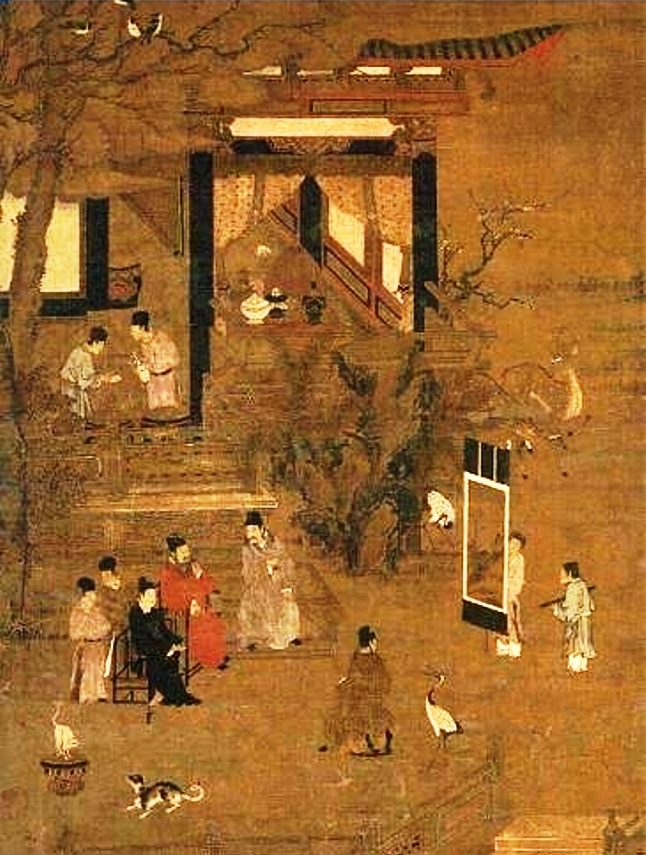
During the 10th century, the Khitans tried to establish relations with Goryeo at least on two occasions. In 942, the Khitan ruler Taizu sent an embassy with a gift of 50 camels to Goryeo, but Taejo refused them, banishing the envoys and starving the camels to death.
Goryeo had maintained relations with most of the Five Dynasties and southern kingdoms in China. By 962, formal relations were established with the Song dynasty. Relations with Song were close, with many embassies being exchanged between Goryeo and Song, but relations would be interrupted by the rise of the Liao and Jin dynasties.
After about 30 years of peace, the Khitans invaded Goryeo. It failed and after two other failed attempts, a state of peace was established in the Far East. For around 100 years, the Far East was relatively peaceful and Munjong strengthened the Liao-Song-Goryeo line.
In 1102, the Jurchen threatened and another crisis emerged. But after Jin agreed to a tributary relationship with Goryeo, peace was maintained and Jin never actually did invade Goryeo.
Tension continued through the 12th century and into the 13th century, when the Mongol invasions started. After a series of battles, Goryeo capitulated to the Mongols, with the direct dynastic rule of Goryeo monarchy
Promotion from one dan to the next can take years. The general rule is that a black belt may advance from one rank to the next only after the number of years equivalent to the current rank. For example, a newly promoted third-degree black belt may not be allowed to advance to fourth-degree until three years have passed. View more information on Black Belt Dan ( 단 ) ».
RESOURCES
This article uses material from the Wikipedia article "Goryeo", which is released under the Creative Commons Attribution-Share-Alike License 3.0.











